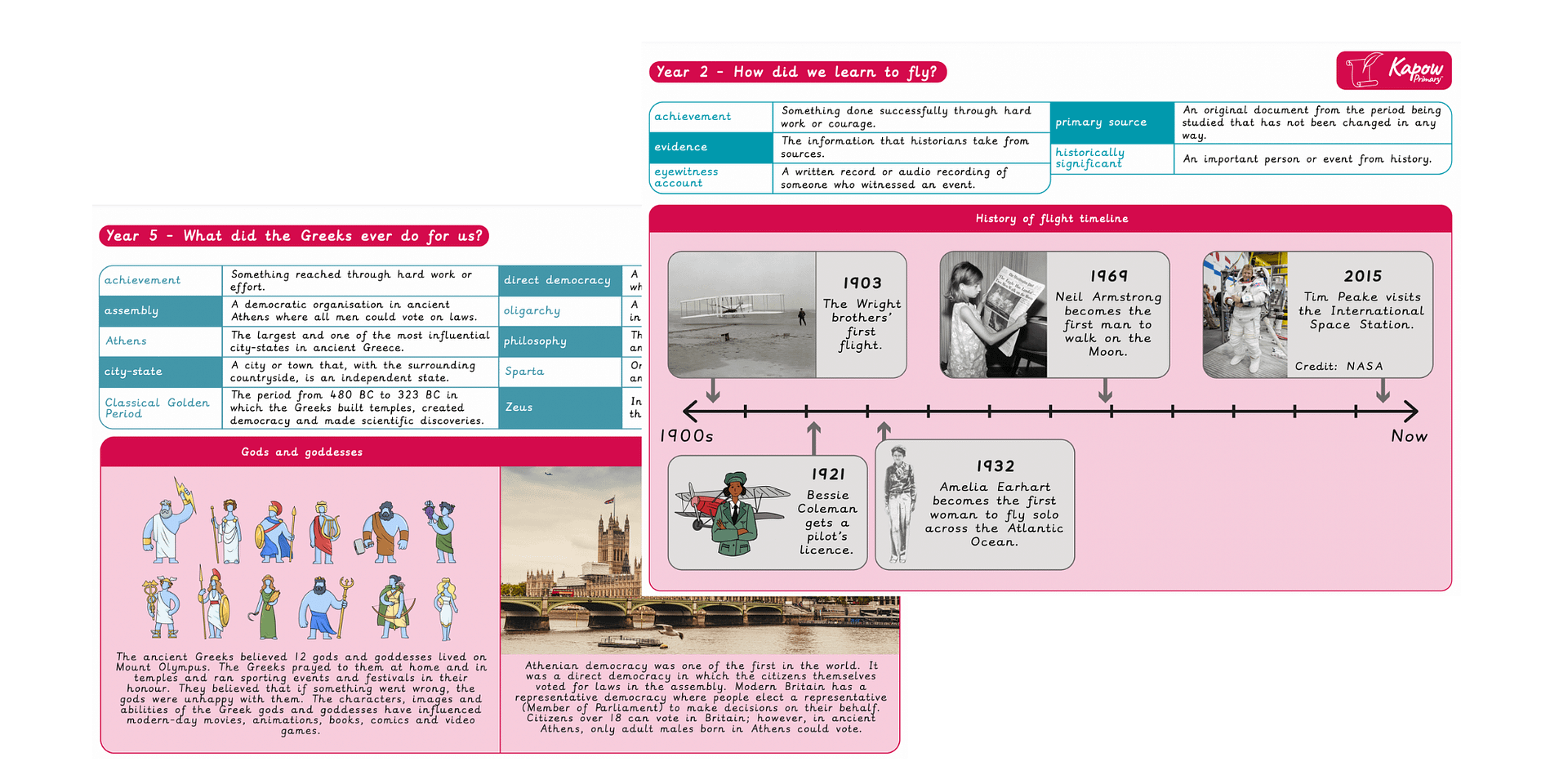Inside Oakfield: A Case Study On The Effective Implementation Of Humanities
Written by Kapow Primary
Published on 27th March 2023
Last Updated: 13th February 2024
Written by Kapow Primary
Published on 27th March 2023
Last Updated: 13th February 2024

Oakfield Schools Federation is a shining example of a school that has embraced creativity and innovation to create a dynamic learning environment that engages and inspires its pupils. They’ve highlighted the strategies they have used, the challenges they have faced, and the results they have achieved. This exciting case study shares how Oakfield School Federation has successfully implemented a range of Kapow Primary’s subjects into their curriculum, including Art and design, Design and technology, History and Geography!
Oakfield is an Infant and Junior School Federation on a split site with a higher than average percentage of SEN pupils and significantly lower than average PP.
Currently, there are 17 teaching staff and 406 pupils on roll. When asked about their teaching values and the most important thing when learning, they answered:
“During our most recent work on developing the curriculum, we had extensive discussions as a staff team to consider what we believed were the golden threads most appropriate to our children and community when devising our new curriculum. After much consideration, we settled on the following ideas:
History, Geography, Art and design and Design and technology.
Our Art co-ordinator discovered Kapow Primary last academic year through talking to colleagues at a different school, and we trialled using Kapow Primary for Art and design. We were so pleased with the sequencing and support for staff subject knowledge that we decided to expand the number of subjects we are using Kapow for.
When looking at what Kapow Primary had to offer, we were intrigued by the subject offers for both History and Geography. We thought the learning would be both interesting for our children and appropriate for our context.
The well-sequenced curriculum is very easy to use for staff with all resources provided, lesson structures clear to follow and a good level of support for staff subject knowledge through information to read and videos to support staff development.
Kapow has allowed us to ensure that teaching is well-sequenced and helps to support children’s learning in foundation subject areas. It has also clarified for staff what the essential knowledge is that children need to be successful in a subject. The lesson structure is also helping us to embed retrieval practice into every lesson through the recap/recall section – this is a key target for our whole school improvement this year.
Very easy! All of the resources are very user-friendly and accessible to all. Staff planning time is now spent researching their key subject knowledge and also ensuring they are aware of where the lesson sits within the sequence (all easily accessible through Kapow) rather than starting their planning for the lesson from scratch.
It has helped reduce staff workload from a planning point of view. It has also allowed subject leaders to discuss their subjects with greater confidence and knowledge regarding the required progression of skills and knowledge. From a teaching and learning point of view, it has helped to define the key knowledge our children need in each subject/topic and allow staff to prioritise this key learning.
The resources are straightforward for staff to use and are explained clearly to help teachers understand the key learning within the lesson and how this fits into the sequence. I think, as staff we have really embraced this scheme. We are really enjoying that it’s a clear sequence and it’s really user-friendly. The key knowledge is clearly identified, and with Kapow Primary, it is so clear that the staff know exactly what the children need to know. The lessons then show you how to teach that, and all the materials are readily available.
It has reduced teacher workload. It has also given us the opportunity to freshen up some of the topics taught, particularly in KS1 leading to greater enthusiasm from our children as learners.
There has been a varied success with regard to this. Where children have struggled, staff have been able to look at the previous learning in the sequence and help support pupils as necessary.
Teachers have found the guidance and videos very supportive. We are only five weeks into using Kapow; the only issue currently raised by staff is that they find it difficult always to fit the content into the lesson time available.
Year 2 has really enjoyed the Geography unit about our wonderful world. They engaged with different types of the atlas, including Google Earth, to investigate Earth’s many amazing human and physical features. They have learned the seven continents and five oceans using catchy songs and are becoming very proficient in mapwork.
It is early days with regard to the implementation of Kapow. The use of British History units in KS2 allows children to demonstrate a chronological narrative of British history, which is really important. Similarly, the Y2 unit How did we learn to fly structures events in a way that ensures children understand the significance of chronology (e.g. how the Wright brothers had to come before Bessie Coleman).
Each Geography unit has a specific fieldwork task to be undertaken by each year group. We have found in the past that this is the element of Geography that staff either struggle with or are reluctant to complete, as it can be tricky. Kapow gives all of the resources and ideas to support staff with this, and it will help provide our children with a fieldwork-rich Geography experience.
Each lesson has a recap section which is clearly drawn from the view of retrieval and metacognitive strategies. This is crucial in supporting children to commit learning to long-term memory.
So far, yes. Although, particularly for history, there could be a greater range of historical sources.
We have started looking at the progression of knowledge and skills to help with assessment alongside the curriculum. We are also looking at ways in which we can incorporate knowledge organisers into our practice.

We haven’t used the assessment yet; we’re trying to embed that in. But in terms of a form of assessment, we are using the retrieval practice right at the start, using the Kapow Primary questions as a guide, and some of the staff are just building on those a bit too. Using this to identify if you want to build on some areas or others that need a bit of reinforcement.
I find that there’s a good amount, and there’s certainly enough for every lesson, but we are just starting with Kapow Primary, so having to backfill some of the prior knowledge with some groups, is making the lesson time longer. The content is good, and in Geography, the fieldwork takes longer than an hour but is made clear to the staff, and they are conscious of that.
There’s a good amount of sources, and all of the videos, the documents and the supporting CPD for teachers is really good. It’s just right – it’s not too much, considering we have one lesson a week – but then we also supplement a little for a Year 6 class whose History knowledge is off the charts!
Yes, we had a deep dive into History. They liked that there was very clear sequencing and that every lesson had CPD for staff with substantive knowledge and disciplinary skills. So it wasn’t just a little bit here and there; it was very clearly thought out.
We have encountered a technical issue with regard to being unable to log on. This issue was resolved very quickly, and the Kapow team were friendly, approachable and helpful as always.
Kapow Primary has revolutionised our History and Geography curriculum. Staff are enthused by the support it offers them to plan and deliver engaging lessons and pupils are thoroughly enjoying the new courses of study and resources they are using within lessons. The teaching model is also supporting our children to remember their learning, which is a vital step in securing knowledge and understanding.
This case study was produced with special thanks to Oakfield School Federation’s Y2 teacher and Curriculum development leader.